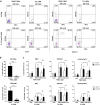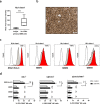Blockade of inhibitory killer cell immunoglobulin-like receptors and IL-2 triggering reverses the functional hypoactivity of tumor-derived NK-cells in glioblastomas
- PMID: 35474089
- PMCID: PMC9042843
- DOI: 10.1038/s41598-022-10680-4
Blockade of inhibitory killer cell immunoglobulin-like receptors and IL-2 triggering reverses the functional hypoactivity of tumor-derived NK-cells in glioblastomas
Abstract
Killer cell immunoglobulin-like receptors (KIRs) comprise a group of highly polymorphic inhibitory receptors which are specific for classical HLA class-I molecules. Peripheral blood and freshly prepared tumor cell suspensions (n = 60) as well as control samples (n = 32) were investigated for the distribution, phenotype, and functional relevance of CD158ab/KIR2DL1,-2/3 expressing NK-cells in glioblastoma (GBM) patients. We found that GBM were scarcely infiltrated by NK-cells that preferentially expressed CD158ab/KIR2DL1,-2/3 as inhibitory receptors, displayed reduced levels of the activating receptors CD335/NKp46, CD226/DNAM-1, CD159c/NKG2C, and showed diminished capacity to produce IFN-γ and perforin. Functional hypoactivity of GBM-derived NK-cells persisted despite IL-2 preactivation. Blockade with a specific KIR2DL-1,2/3 monoclonal antibody reversed NK-cell inhibition and significantly enhanced degranulation and IFN-γ production of IL-2 preactivated NK-cells in the presence of primary GBM cells and HLA-C expressing but not HLA class-I deficient K562 cells. Additional analysis revealed that significant amounts of IL-2 could be produced by tumor-derived CD4+ and CD8+CD45RA- memory T-cells after combined anti-CD3/anti-CD28 stimulation. Our data indicate that both blockade of inhibitory KIR and IL-2 triggering of tumor-derived NK-cells are necessary to enhance NK-cell responsiveness in GBM.
© 2022. The Author(s).
Conflict of interest statement
C.S., J.W., M.H, B.B., W.S. and C.T. declare that they have no conflict of interest. A.S.M. received research support and travel expenses from Novartis. H.W. received compensation for serving on scientific advisory boards/steering committees and as a consultant from Bayer Healthcare, Biogen, Sanofi Genzyme, Merck Serono, Roche, and Novartis. He has received speaker honoraria and travel support from Bayer Vital GmbH, Bayer Schering AG, Biogen, CSL Behring, EMD Serono, Fresenius Medical Care, Genzyme, Merck Serono, Omniamed, Novartis, and Sanofi Aventis. H.W. also received research support from Bayer Healthcare, Bayer Vital, Biogen, Merck Serono, Novartis, Sanofi Genzyme, Sanofi US and Teva Pharma, Merck Serono, and Novartis. O.M.G. received speaker honoraria and travel expenses from Roche, Bristol- Myers Squibb and MagForce. He received compensation as a consultant from Gilead Sciences and Bayer AG.
Figures





Similar articles
-
Hierarchy of the human natural killer cell response is determined by class and quantity of inhibitory receptors for self-HLA-B and HLA-C ligands.J Immunol. 2007 Nov 1;179(9):5977-89. doi: 10.4049/jimmunol.179.9.5977. J Immunol. 2007. PMID: 17947671
-
Education of human natural killer cells by activating killer cell immunoglobulin-like receptors.Blood. 2010 Feb 11;115(6):1166-74. doi: 10.1182/blood-2009-09-245746. Epub 2009 Nov 10. Blood. 2010. PMID: 19903900
-
Increased frequency and function of KIR2DL1-3⁺ NK cells in primary HIV-1 infection are determined by HLA-C group haplotypes.Eur J Immunol. 2014 Oct;44(10):2938-48. doi: 10.1002/eji.201444751. Epub 2014 Aug 12. Eur J Immunol. 2014. PMID: 25043727 Free PMC article.
-
KIR specificity and avidity of standard and unusual C1, C2, Bw4, Bw6 and A3/11 amino acid motifs at entire HLA:KIR interface between NK and target cells, the functional and evolutionary classification of HLA class I molecules.Int J Immunogenet. 2019 Aug;46(4):217-231. doi: 10.1111/iji.12433. Epub 2019 Jun 18. Int J Immunogenet. 2019. PMID: 31210416 Review.
-
The role genes encoding of killer cell immunoglobulin-like receptors (KIRs) and their ligands in susceptibility to and progression of HIV infection.Postepy Hig Med Dosw (Online). 2016 Dec 31;70(0):1409-1423. doi: 10.5604/17322693.1227771. Postepy Hig Med Dosw (Online). 2016. PMID: 28100849 Review.
Cited by
-
Recombinant Human Interleukin-2 Corrects NK Cell Phenotype and Functional Activity in Patients with Post-COVID Syndrome.Pharmaceuticals (Basel). 2023 Apr 3;16(4):537. doi: 10.3390/ph16040537. Pharmaceuticals (Basel). 2023. PMID: 37111294 Free PMC article.
-
Advancing cancer immunotherapy: from innovative preclinical models to clinical insights.Sci Rep. 2024 Jan 12;14(1):1205. doi: 10.1038/s41598-024-51704-5. Sci Rep. 2024. PMID: 38216668 Free PMC article.
-
Focusing on NK cells and ADCC: A promising immunotherapy approach in targeted therapy for HER2-positive breast cancer.Front Immunol. 2022 Dec 19;13:1083462. doi: 10.3389/fimmu.2022.1083462. eCollection 2022. Front Immunol. 2022. PMID: 36601109 Free PMC article. Review.
-
The effects of degraded polysaccharides from Acanthopanax senticosus on growth, antioxidant and immune effects in broiler chicks based on intestinal flora.Poult Sci. 2025 Apr;104(4):104933. doi: 10.1016/j.psj.2025.104933. Epub 2025 Feb 21. Poult Sci. 2025. PMID: 40010047 Free PMC article.
-
Immune-related lncRNAs signature and radiomics signature predict the prognosis and immune microenvironment of glioblastoma multiforme.J Transl Med. 2024 Jan 26;22(1):107. doi: 10.1186/s12967-023-04823-y. J Transl Med. 2024. PMID: 38279111 Free PMC article.
References
Publication types
MeSH terms
Substances
LinkOut - more resources
Full Text Sources
Research Materials

